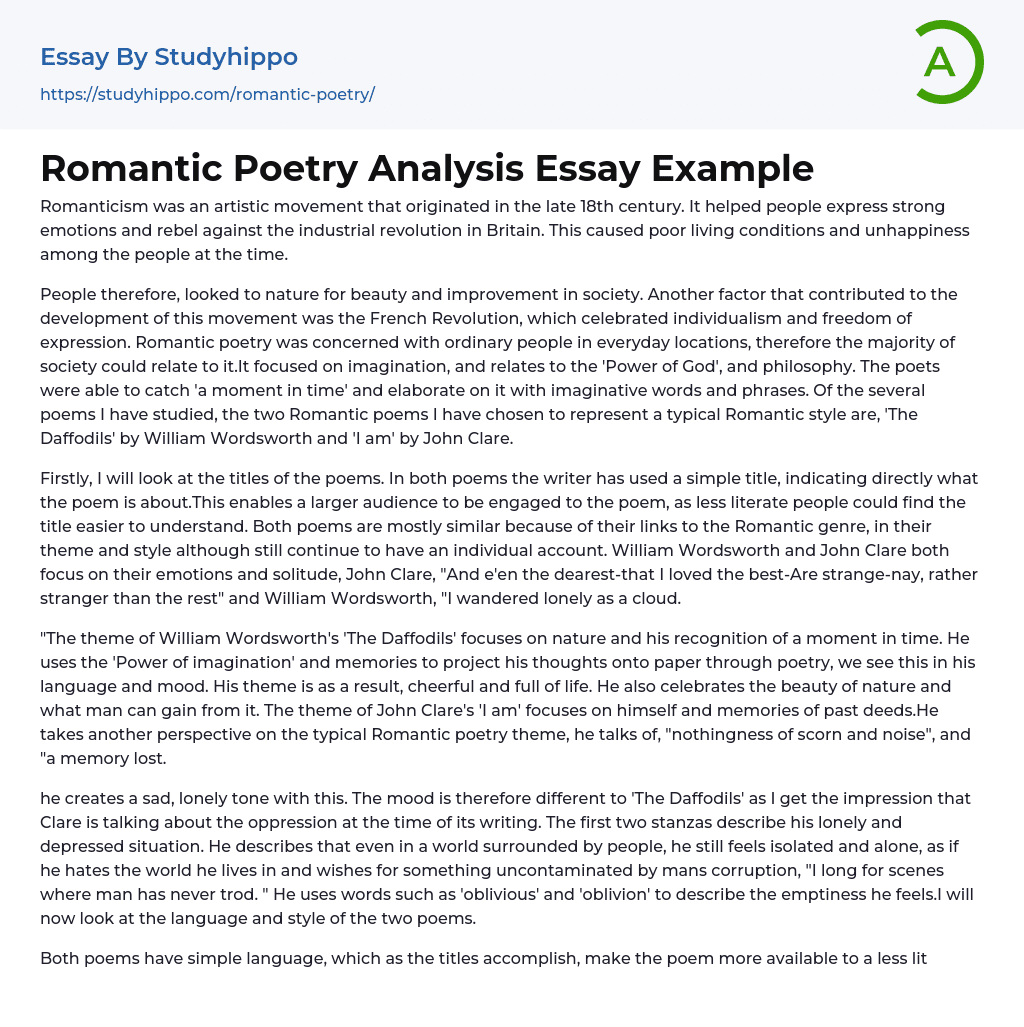Romanticism was an artistic movement that originated in the late 18th century. It helped people express strong emotions and rebel against the industrial revolution in Britain. This caused poor living conditions and unhappiness among the people at the time.
People therefore, looked to nature for beauty and improvement in society. Another factor that contributed to the development of this movement was the French Revolution, which celebrated individualism and freedom of expression. Romantic poetry was concerned with ordinary people in everyday locations, therefore the majority of society could relate to it.It focused on imagination, and relates to the 'Power of God', and philosophy. The poets were able to catch 'a moment in time' and elaborate on it with imaginative words and phrases. Of the several poems I have studied, the two Romantic poems I
...have chosen to represent a typical Romantic style are, 'The Daffodils' by William Wordsworth and 'I am' by John Clare.
Firstly, I will look at the titles of the poems. In both poems the writer has used a simple title, indicating directly what the poem is about.This enables a larger audience to be engaged to the poem, as less literate people could find the title easier to understand. Both poems are mostly similar because of their links to the Romantic genre, in their theme and style although still continue to have an individual account. William Wordsworth and John Clare both focus on their emotions and solitude, John Clare, "And e'en the dearest-that I loved the best-Are strange-nay, rather stranger than the rest" and William Wordsworth, "I wandered lonely as a cloud.
"The theme of William Wordsworth's 'The Daffodils' focuses on nature an
his recognition of a moment in time. He uses the 'Power of imagination' and memories to project his thoughts onto paper through poetry, we see this in his language and mood. His theme is as a result, cheerful and full of life. He also celebrates the beauty of nature and what man can gain from it. The theme of John Clare's 'I am' focuses on himself and memories of past deeds.He takes another perspective on the typical Romantic poetry theme, he talks of, "nothingness of scorn and noise", and "a memory lost.
he creates a sad, lonely tone with this. The mood is therefore different to 'The Daffodils' as I get the impression that Clare is talking about the oppression at the time of its writing. The first two stanzas describe his lonely and depressed situation. He describes that even in a world surrounded by people, he still feels isolated and alone, as if he hates the world he lives in and wishes for something uncontaminated by mans corruption, "I long for scenes where man has never trod. " He uses words such as 'oblivious' and 'oblivion' to describe the emptiness he feels.I will now look at the language and style of the two poems.
Both poems have simple language, which as the titles accomplish, make the poem more available to a less literate lower class reader. The rhyme schemes are regular throughout the poems, 'The Daffodils', ABABCC and 'I am', ABABBB. The punctuation is also similar, as they both create a slow pace by using a small amount of punctuation. 'The Daffodils' has eight syllables in each line, whereas 'I am' does not have
a precise amount.'The Daffodils' uses similes, "as a cloud" and "as the stars that shine.
by using these he enables the reader to compare what he sees to something they see. In his language he uses onomatopoeia, such as 'fluttering' and 'twinkle', this enables the reader to almost hear the sounds as they are reading the words. He also uses personification; this makes the flowers seem to be. He also uses words such as, "jocund company" and "continuous as the stars that shine. " This relates to his everlasting memory of these beautiful daffodils that no one can take away from him.The two poems have different structures; 'The Daffodils' has four sestet stanzas and 'I am' has three sestet stanzas, John Clare uses enjambment, making the first and second verse flow into each other.
In his last stanza he wishes to go to an untouched place, "were man has never trod. " He wishes for beauty and tranquillity not for what he sees in the world at that moment in time. He uses a metaphor, "But the vast shipwreck of my life's," this lets the reader picture how troubled he is in this world and wishes for a better place.
- 1984 essays
- A Farewell to Arms essays
- A Good Man Is Hard to Find essays
- A Hanging essays
- A Lesson Before Dying essays
- A Long Way Gone essays
- A Rose For Emily essays
- A Separate Peace essays
- A Tale Of Two Cities essays
- A Very Old Man With Enormous Wings essays
- Adventures Of Huckleberry Finn essays
- Alice in Wonderland essays
- All Quiet on The Western Front essays
- Allegory of the Cave essays
- An occurrence at owl creek bridge essays
- Animal Farm essays
- Anthem essays
- Antigone essays
- Arthur Conan Doyle essays
- As I Lay Dying essays
- Atticus Finch essays
- Barn Burning essays
- Battle Royal essays
- Beauty and The Beast essays
- Beloved essays
- Boo Radley essays
- Brave New World essays
- Candide essays
- Castle essays
- Characters In Hamlet essays
- Characters In Romeo And Juliet essays
- Christmas carol essays
- Chronicle of a Death Foretold essays
- Cinderella essays
- Crime and Punishment essays
- Daisy Miller essays
- Death of a Salesman American Dream essays
- Desdemona essays
- Diary Of A Wimpy Kid essays
- Dracula essays
- Dubliners essays
- Emma essays
- Ender'S Game essays
- Ethan Frome essays
- Eveline essays
- Fahrenheit 451 essays
- First-Person Narrative essays
- Fish Cheeks essays
- Frankenstein essays
- Genesis essays




